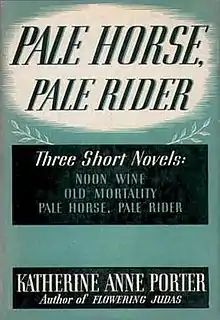Pale Horse, Pale Rider
Pale Horse, Pale Rider (ISBN 0-15-170755-3) is a collection of three short novels by American author Katherine Anne Porter published in 1939.

While these three short novels "Old Mortality," "Noon Wine" and the eponymous "Pale Horse, Pale Rider," have been described as novellas, Porter referred to them as short novels. Porter, in the preface "Go Little Book . . " to "The Collected Stories of Katherine Anne Porter," abjured the word "novella," calling it a "slack, boneless, affected word that we do not need to describe anything." She went on to say "Please call my works by their right names: we have four that cover every division: short stories, long stories, short novels, novels."[1] The title story "Pale Horse, Pale Rider" is about the relationship between a newspaper woman, Miranda, and a soldier, Adam, during the influenza epidemic of 1918. In the course of the narrative, Miranda becomes sick and delirious, but recovers, only to find that Adam has died of the disease, which he likely caught while tending to her. The story is set in Denver, Colorado. Porter herself lived for a time in Denver, where she wrote reviews for the Rocky Mountain News and was stricken with the influenza. The historian Alfred W. Crosby considered Pale Horse, Pale Rider to be such an exceptional depiction of the suffering caused by the influenza that he dedicated his book about the 1918 epidemic to Porter. The author Robert Penn Warren said "Pale Horse, Pale Rider" was “at the top level, you know, in that collection of the world’s short novels.”[2] The book also includes the stories "Noon Wine" and "Old Mortality." The title comes from an African-American spiritual that the story references, which begins "Pale horse, pale rider, done took my lover away." The spiritual in turn is Biblical, coming from Revelation 6:1-8. There, the Four Horsemen of the Apocalypse are the Conqueror on a white horse, War on a red horse, Famine on a black horse, and Death on a pale horse.
Theme
Porter herself said that the title story was about the pale rider, Death, who takes away an entire era, as illustrated in the ironic last line: "Now there would be time for everything."
References
- Katherine Anne Porter (1965). The Collected Stories of Katherine Anne Porter. New York: Harcourt, Brace & World. pp. v. ISBN 9780156188760.
- A Writer's Writer: Preserving the Archives of Katherine Anne Porter," by Sara E. Wilson, Humanities, September/October 1998, Volume 19/Number 5